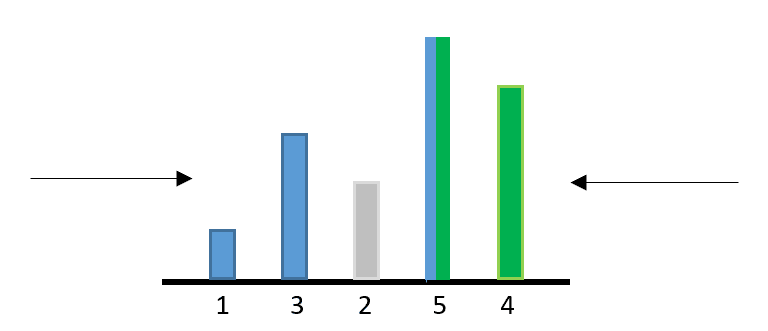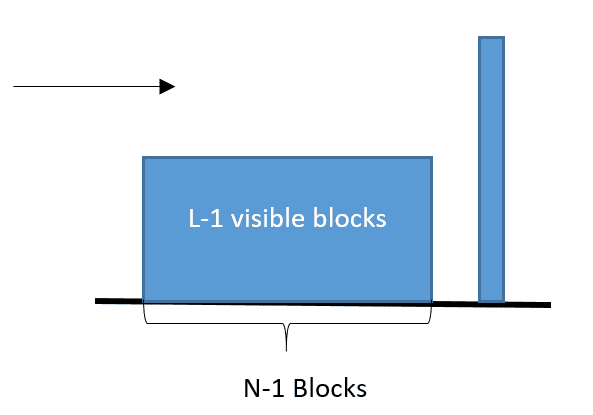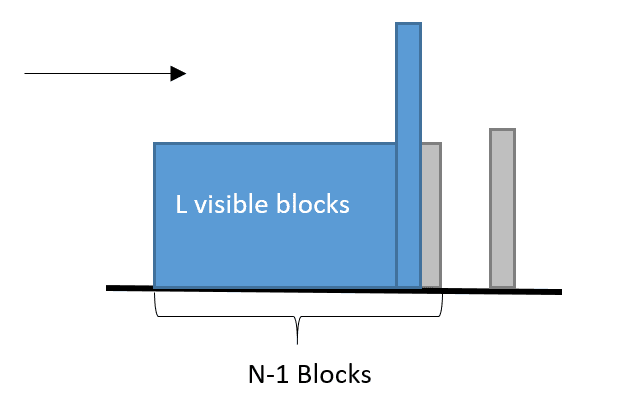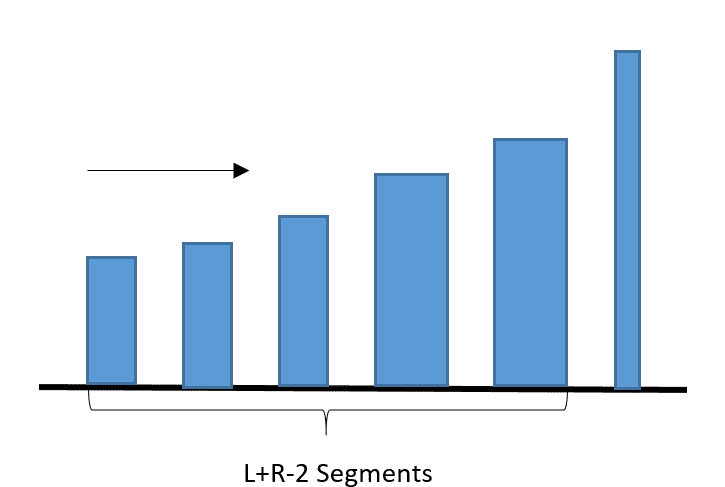1. Introduction
In this tutorial, we’ll see how to compute the number of ways to arrange the blocks with
visible blocks on the left and
visible ones on the right.
2. Problem Description
There are uniquely-sized blocks whose heights are integers from
to
. How many ways to arrange the
blocks in a row such that exactly
blocks are visible from the left and
blocks are visible from the right?
A block is visible from the left if there are no longer blocks to the left of it. Similarly, a block is visible from the right if there are no longer blocks to the right of it.
For example, if we arrange blocks with
, then the blocks with heights
,
, and
are visible from the left. Also, blocks with heights
and
are visible from the right:

The longest block with the height of is visible from both sides.
3. Solve the Left Part
Let’s first consider the left part only. Given blocks, let
denote the number of ways to arrange them with
visible blocks from the left. We can divide this problem into two cases.
For the first case, we place the longest block in the end. In this way, the longest block is always visible from the left no matter how we arrange the rest blocks. Therefore, the problem becomes to solve
as we need to find the number of ways to arrange the remaining
blocks with
visible ones:

For the second case, we place any block other than the longest one in the end. Since the longest block is not at the end position, it hides any blocks right after it, including the last one. Therefore, we should not count the last block as the visible block from the left. To make visible blocks from the left, we have to arrange them on the remaining
blocks. Therefore, the problem becomes to solve
to arrange the remaining
blocks with
visible ones:

Since we have possible ways to put a short block into the last position, the total number of ways for the second case is
.
Based on the above observations, we can have our recurrence formula:
For the base case, if we have only one block, then there is only one way to see it visible from the left. Therefore, we can have . Also, we have
for
.
We can use a dynamic programming approach to compute the :
algorithm ArrangeBlocksLeft(N, L):
// INPUT
// N = the total number of blocks
// L = the number of visible blocks from the left
// OUTPUT
// Number of ways to arrange N blocks so that L blocks are visible from the left
Construct a 2-D array dp of size (N+1)x(L+1) with initial values of 0
dp[1, 1] <- 1
for n <- 2 to N:
for l <- 1 to L:
dp[n, l] <- dp[n - 1, l - 1] + (n - 1) * dp[n - 1, l]
return dp[N, L]
This algorithm uses a two-dimensional array, , to compute the
. The array has
rows and
columns, as the array index starts from
. We use this array to store the computed
values. When we compute
with bigger
and
, we can reuse the previously computed results from the smaller numbers.
Firstly, we store the base case, , into the
array. Then, we use nested loops to go through all possible
and
values and compute
based on our recurrence formula. After we finish the computing,
is the result we want.
Since we have two nested loops over the numbers and
, the overall time complexity of this algorithm is
.
4. S0lve Both Parts
Let’s consider an arrangement that contains visible blocks from the left and
visible blocks from the right. For each visible block, we treat this block and all blocks between it and the next visible block as a whole segment. The longest block is a segment that contains itself only. Also, it is visible from both sides. Therefore, there are
segments before the longest block segment and
segments after the longest block segments:

For each segment on the right side, we can reverse the order of the blocks and move the whole segment to the left side. This makes segments before the longest block. Also, we can sort these segments based on the highest block in each segment. In this way, we can have
visible blocks to the left of the longest block:

Similarly, given a block arrangement where the longest block is at the last position and there are visible blocks from the left, we can pick
segments and move them to the right of the longest block. In this way, we can have a block arrangement that contains
visible blocks from the left and
visible blocks from the right.
Therefore, we can reduce the original problem to a smaller problem that computes the arrangement where the longest block is at the end position and there are visible blocks among the rest
blocks, which is
.
Also, among the segments, we can choose any
segments and move them to the right. Therefore, the overall number of possible ways is
, which is also
.
We can use a factorial function and the previous function to calculate our result:
algorithm ArrangeBlocks(N, L, R):
// INPUT
// N = the total number of blocks
// L = the number of visible blocks from the left
// R = the number of visible blocks from the right
// OUTPUT
// The number of ways to arrange N blocks so that
// L blocks are visible from the left and R blocks are visible from the right.
numerator <- Factorial(L + R - 2)
denominator <- Factorial(L - 1) * Factorial(R - 1)
return numerator / denominator * ArrangeBlocksLeft(N - 1, L + R - 2)
// Function to calculate the factorial of a number
algorithm Factorial(n):
// INPUT
// n = an integer
// OUTPUT
// Returns the factorial of n.
result <- 1
for i <- 2 to n:
result <- result * i
return result
The time complexity for the factorial functions is . Also, the
function takes
time. Therefore, the overall time complexity of this algorithm is
5. Conclusion
In this tutorial, we showed a dynamic programming algorithm to compute the number of arrangements for blocks with
visible blocks from the left. Based on this algorithm, we can extend to compute the number of arrangements for
blocks with
visible blocks from the left and
visible blocks from the right.